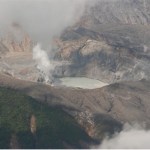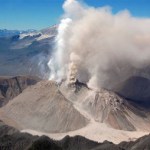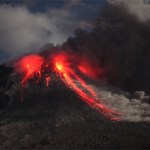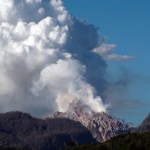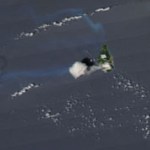Chaiten
Finally, a chance to catch up a bit ... !
Yasur erupting in May of 2010.
Some news from the world of volcanoes:
The BBC has a series of videos one the fallout from the Eyjafjallajökull eruption - including a look at the area around the volcano and how the economy has been affected by the eruption. However, things seem pretty quiet at the summit of the Eyjafjallajökull summit where snow can begun to settle without melting - and the Icelandic Met Office appears to think that the eruption is more or less (but not officially) over. And take this press release as you will, but a recent study…
The latest Weekly Volcanic Activity Report from our friends at the Smithsonian Global Volcanism Program and the USGS.
Highlights (not including Eyjafjallajökull - you can check the latest IMO update on that eruption and the latest VAAC ash advisories.):
Villarrica in Chile was raised from Alert Level 1 to 2 by the Chilean SERNAGEOMIN after an increase in seismicity, a rise in the lava lake levels at the summit and more vigorous fumarolic activity.
In the first update in a while, a small ash plume was noticed at Chaiten in Chile, rising to ~1.8 km (8,000 feet) from the new domes.
Karymsky in…
Chaiten in Chile erupting on May 5, 2008, four days after the volcano came back to life after ~9,000 years of dormancy.
Quick post ... but until I was reminded by Eruptions reader Guillermo, I had forgotten two important anniversaries.
First, today (May 1) marks the 2nd anniversary of the start of the Chaiten eruption in Chile. The eruption is still rumbling along (spanish), with growth of three domes in the Chaiten caldera. I'll have more to say about this on Monday.
Secondly, today also marks the second anniversary for the start of this blog! Yes, if you can believe it, Eruptions turns two…
Gaua erupting in February 2010. Image courtesy of the NASA Earth Observatory.
As a certain famous Icelandic native would say, "there is more to life than this."
Some other volcano news from around the world:
The situation at Gaua in Vanuatu is worsening. Ash from the current eruption is contaminating water and food supplies on the island. Authorities are planning on evacuating 3,000 people from the island if the eruption that started in 2009 gets worse, but there has already been significant ash fall, mudflows and explosions.
Shiveluch on the Kamchatka Peninsula in eastern Russia continues…
Actually, no the volcanoes aren't from space, but pictures of the volcanoes were taken from space. The NASA Earth Observatory has posted three more gems of volcanic activity taken by one of the fleet of earth imagers in orbit:
A recent image of Chaiten taken by EO-1. Image courtesy of the NASA Earth Observatory.
There is a great image of the busy Kamchatkan Peninsula, where four volcanoes are seen erupting in a single image - Kliuchevskoi, Bezymianny, Shiveluch and Karymsky. The plume from Karymsky is especially prominent as a grey streak above the white snow of the Russian winter (albeit…
Did I mention its a busy week?
The lava lake at Erta'Ale in 2008. Image courtesy of Stromboli Online.
Our Icelandic saga continues, with more earthquakes and more speculation/information on the parts of Eruptions readers. Keep up the discussion - I'll be fascinated to see who turns out to get closest to what actually happens, prediction-wise. The seismicity has quieted somewhat again in the last 12 hours, so we wait eagerly to see what comes next. Remember, Iceland is the land where volcanoes helped change history, so it is always fun to talk Icelandic volcanism.
The NASA Earth Observatory…
Cleaning up some news ... busy week leading up to a field trip I am helping co-lead to Death Valley next week.
Ubehebe Crater in Death Valley, California
First off, I want to say how amazed I am at the great discussion that went on all weekend about the signs of potential activity in Iceland. It now appears that the earthquakes at Eyjafjallajökull may be waning, however the levels of seismicity have definitely bounced up and down over the last few days. However, the level and depth of the conversation is a testament to all volcanophiles out there. Nice job, folks.
For those of you into…
Some news for a busy Tuesday:
The crater at Poas volcano in Costa Rica, taken February 25, 2010. Image courtesy of OVSICORI by Federico Chavarria.
After the MSNBC debacle, it is nice to see some good articles on why the Chilean earthquake was overall less disastrous than the Haitian earthquake, why the tsunami wasn't as large as predicted and why these earthquakes are not abnormal. There are a lot of factors involved - the location, depth, preparedness, wealth - so the comparison can be very telling in terms of both geologic and societal issues.
The other scientific fallout from the Chilean…
The rhyolite domes of Chaiten in Chile in an undated photo. Note how much of the previous Chaiten Caldera has already been filled by the new domes that started after Chaiten erupted in May 2008.
CNN International has a report that the National Emergency Office (ONEMI) in Chile has reinforced the "red alert" status of Chaiten (spanish). The volcano, which has been erupting since May 2008, had recently settled down to slow, but constant, dome growth. However, over the last 3 weeks, seismicity has been increasing at the rhyolite caldera, suggesting that we might be heading towards an upswing of…
Not a lot of big news, but a lot of little news:
Soufriere Hills at night during the late January 2010 dome growth episode. Note the hot rock falls from the collapsing dome. Image courtesy of Photovolcanica.
This might not be new, but Dr. Boris Behncke brought the new webcam at the rim of Chaiten in Chile to my attention. You get a birds-eye view of the growing dome from the edge of the caldera - pretty nifty view for a once-in-a-hundred-years sort of event.
The NASA Earth Observatory has posted a close-up of the Soufriere Hills imagethat I posted yesterday, showing the February 11 plume.…
The weekly volcano report, brought to you by our friends at the Smithsonian Global Volcanism Program and the U.S. Geological Survey.
Highlights (not including Mayon, Nyamuragira and Turrialba):
Eruptions continue at Piton de la Fournaise on Reunion Island - heck, this would be the volcano news if it wasn't for all these other, more explosive systems getting in the way. Lava fountains, flows and pools were the order of the day in the SW Dolomieu crater until the 12th of January.
Chaiten in Chile continues to chug along - block-and-ash flows were seen and ash plumes continue to emanate from…
2009 is over! If you missed the Volcanic Year in Review, check out my summary of the volcanic events that captivated many of us over the past year. However, only one event will get the coveted 2009 Pliny for Volcanic Event of the Year. A lot of you wrote in with votes and comments - I thank you - and a number of events stood out in your mind. Here we go:
Honorable mention
A few volcanic events got multiple votes:
- Soufriere Hills on Montserrat.
- Mando Hararo in Ethiopia.
- Chaiten, Chile and the new research on the eruption.
- The earthquakes in western Saudi Arabia under the Harrat…
Here it is, my attempt to recap a year's worth of volcanic events. By no means is this supposed to capture every event, but rather the highlight/lowlights and what most captivated me during 2009. I'll be announcing the winner of the 2009 Pliny for Volcanic Event of the Year tomorrow.
Waimangu Geothermal Valley in New Zealand, taken in January 2009 by Erik Klemetti.
January
The year started out with a trip to New Zealand (well, for me at least) and vistas of the Waimangu Valley, formed in the 1886 eruption of Tarawera on the North Island. We were also still thinking about the late 2008…
We get a new update from the Smithsonian/USGS Global Volcanism Program ...
Highlights (not counting Soufriere Hills or Gaua) include:
The Weekly Report mentions the mystery eruption/noneruption of Karkar in PNG. Specifically, they report:
The report also stated that ash had merged with a thunderstorm cloud and had become unidentifiable.
Two ash plumes (11/25, 26) that reached at least 9.1 km / 30,000 feet were reported by the Darwin VAAC ... but as we know, it is far from clear that anything actually happened at Karkar last week.
Activity has quieted significantly at Chaiten in Chile, with…
I'll be giving a talk this afternoon here at Denison on rhyolite generation, so I might be a little brief this morning.
Undated image of Mayon in the Philippines.
The province of Albay in the Philippines is on alert for both a typhoon and a volcano (that country seems to be hit with that 300,000 may need to be ready to evacuate if the volcano continues to show signs that it might erupt - in fact, Mayon is producing ash as of this morning, albeit only one minor ash explosion.
Lava flows from Kilauea are drawing crowds as they inundate a road in Kalapana. There is a nice video link to the…
A few weeks ago I asked you to submit questions on the 2008-present Chaiten eruption in Chile to pose to Dr. Jonathan Castro. Dr. Castro recently had a paper on the ascent rates of Chaiten rhyolite published in Nature and he kindly volunteered to answer your questions. Here are the answers to selected questions ... enjoy!
Chaiten in Chile erupting in 2009. Image by Dr. Jonathan Castro.
Dr. Jonathan Castro
Biography:
B.S. from Humboldt State University
Ph.D. from University of Oregon*
Currently a Research Geologist at CNRS-Institut for Sciences de la Terre, Oreans, France
Soon moving on to…
I mentioned this at the end of the post on recent Nature paper by Castro and Dindwell on the speed of rhyolite magma ascent at Chaiten, but I'll break it out to get your attention:
>Do you have a burning question about the Chaiten magma you'd love to be able to ask Dr. Castro? He has kindly offered to answer some questions about Chaiten and his research for Eruptions readers. Send me your questions at
and I'll choose some of them for Dr. Castro to answer. I'll post the interview and the answers to your questions here on the blog.
So do it! Send me your questions for Dr. Castro!
Chaiten has made it back into the news in the past couple days, both with new events at the caldera and with findings from the initial blast in May 2008. Here goes:
Chaiten erupting in 2008.
Third Dome Spotted
The latest USGS/SI Weekly Volcanic Activity Report mentions that over the last week, Chaiten experienced what was likely a significant dome collapse of one of the two domes growing in the caldera. People living close enough to the volcano to see the ash plume noticed it became larger and darker on September 29th. Afterwards, visual observations of the caldera by air confirmed that a…
Sometimes it is hard to keep up with the mountain of remote sensing (or not so remote) images that get released on the internet. Over the last few days, the NASA Earth Observatory has released a bunch of images/videos of current eruptions, so I thought I'd round them all up here for you to peruse.
Soufriere Hills releasing puffs of ash-and-steam on October 6, 2009. Image courtesy of the NASA Earth Observatory.
Four new images in the recent past:
A nice, clear picture of an ash-and-steam plume from Rabaul in PNG was captured by the Terra satellite's MODIS imager on September 30, 2009. The…
As fall descends on the northern hemisphere, spring starts in the southern. Luckily for us, it means that we get better views of the southern Andes in Chile ... which means the NASA EO could train one of the many "eyes in the sky" (specifically the EO-1) on Chaiten. The volcano is still erupting, going on 16 months, since it caught everyone off guard in May of 2008. As you can tell from the image (linked and below), Chaiten is slowly filling in the pre-2008 caldera with new rhyolite dome growth - you can see that the pre-2008 dome within the caldera (see the picture taken from the ISS in 2003…
